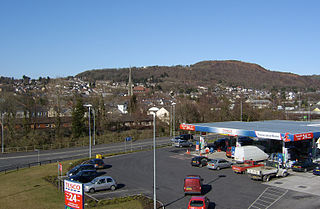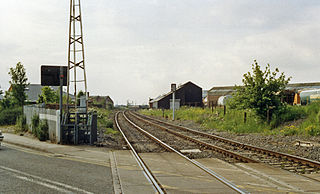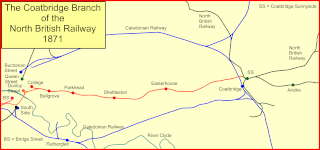
Pontardawe is a town and a community in the lower Swansea Valley. it had a population of approximately 7,172 in the 2021 Census for Pontardawe Parish, and forms part of the county borough of Neath Port Talbot.

Crown Street railway station was the Liverpool terminus railway station of the Liverpool and Manchester Railway in Liverpool, England, it opened on 15 September 1830. The station was one of the world's first on an inter-city passenger railway in which all services were operated by mechanical traction.

The Maryport & Carlisle Railway (M&CR) was an English railway company formed in 1836 which built and operated a small but eventually highly profitable railway to connect Maryport and Carlisle in Cumberland, England. There were many small collieries in the area and efficient access to the harbour at Maryport was important.

The Swansea Vale Railway (SVR) was a railway line connecting the port of Swansea in South Wales to industries and coalfields along the River Tawe on the northern margin of Swansea, by taking over a tramroad in 1846. It was extended to Brynamman in 1868. Passengers were carried from 1860, and a loop line through Morriston was built.

The Swansea Canal was a canal constructed by the Swansea Canal Navigation Company between 1794 and 1798, running for 16.5 miles (26.6 km) from Swansea to Hen Neuadd, Abercraf in South Wales. It was steeply graded, and 36 locks were needed to enable it to rise 373 feet (114 m) over its length. The main cargos were coal, iron and steel, and the enterprise was profitable.
The Derbyshire and Staffordshire extension of the Great Northern Railway was an English railway network built by the GNR to get access to coal resources in the area to the north and west of Nottingham. The Midland Railway had obstructed the GNR in its attempts to secure a share of the lucrative business of transporting coal from the area, and in frustration the GNR built the line. The line was forked: it reached Pinxton in 1875 and a junction with the North Staffordshire Railway at Egginton, approaching Burton on Trent in 1878. The line cut through Derby, resulting in considerable demolition of housing there.
The Amman Valley Railway Society is situated near the former Gwaun Cae Gurwen branch line, that runs alongside the River Amman, some 10 miles (16 km) north of Swansea in west Wales. Its primary focus is to construct Swansea 9 Lines, an eco-friendly tram system to the heart of Swansea and the surrounding areas. The project was originally based on a heritage railway proposal on a lines that formerly served the various collieries of the area north of Swansea and Llanelli.
The Swansea Valley is one of the South Wales Valleys. It is the valley from the Brecon Beacons National Park to the sea at Swansea of the River Tawe in Wales. Administration of the area is divided between the City and County of Swansea, Neath Port Talbot County Borough, and Powys. A distinction may be drawn between the Lower Swansea valley and the Upper Swansea valley; the former was more heavily industrialised during the 19th and 20th centuries.

The Wonthaggi railway line is a closed railway line located in South Gippsland, Victoria, Australia. Its primary purpose was to serve the State Coal Mine but the line also provided passenger and general goods services. The line was opened in 1910 and closed in 1978.
The Vale of Neath Railway (VoNR) was a broad gauge railway company, that built a line from Merthyr Tydfil and Aberdare to Neath, in Wales, mostly to transport the products of the Merthyr iron industries to ports on Swansea Bay.
The Kincardine Line is a railway in Clackmannanshire and Fife, Scotland. It was originally built to serve settlements along the north shore of the Firth of Forth, between Alloa and Dunfermline.

The Edinburgh and Dalkeith Railway was an early railway built to convey coal from pits in the vicinity of Dalkeith into the capital. It was a horse-operated line, with a terminus at St Leonards on the south side of Arthur's Seat.

The Leicester–Burton upon Trent line is a freight-only railway line in England linking the Midland Main Line near Leicester to the Derby to Birmingham line at Burton upon Trent. The line was built by the Midland Railway, which had acquired the Leicester and Swannington Railway in 1847, improving it and extending it. It opened throughout in 1849. The line connected an exceptional number of collieries and industrial premises, and several industrial branch lines were built radiating from it. Swadlincote was already an established community engaged in industry and there was a complex of branch lines there. The passenger service on the line was discontinued in 1964, and much of the mining-based industry has closed down; quarrying is the dominant residual originating traffic. There are proposals to reopen the passenger service, and these are under review at present (2022).
Brownhills Watling Street railway station was a station on the Midland Railway in England. It was opened in 1884, closed in March 1930 for passenger use and the track was closed in 1960.
The Great Northern and Great Eastern Joint Railway, colloquially referred to as "the Joint Line" was a railway line connecting Doncaster and Lincoln with March and Huntingdon in the eastern counties of England. It was owned jointly by the Great Northern Railway (GNR) and the Great Eastern Railway (GER). It was formed by transferring certain route sections from the parent companies, and by the construction of a new route between Spalding and Lincoln, and a number of short spurs and connections. It was controlled by a Joint Committee, and the owning companies operated their own trains with their own rolling stock. The Joint Line amounted to nearly 123 miles (198 km) of route.
The Rutherglen and Coatbridge Railway was a railway line in Scotland built by the Caledonian Railway to shorten the route from the Coatbridge area to Glasgow. It opened in 1865. It was later extended to Airdrie in 1886, competing with the rival North British Railway. Soon after a further extension was built from Airdrie to Calderbank and Newhouse.

The Coatbridge Branch of the North British Railway was a railway built to connect the important coal and iron industrial districts of Coatbridge and Airdrie directly to Glasgow for the North British Railway.
Penton railway station served the parish of Penton from 1862 to 1969 on the Border Union Railway.
The Glasgow, Bothwell, Hamilton and Coatbridge Railway was a railway company in Scotland, built to serve coal and ironstone pits in the Hamilton and Bothwell areas, and convey the mineral to Glasgow and to ironworks in the Coatbridge area. It was allied to the North British Railway, and it opened in 1877. Passenger services followed.
Abernant Colliery was a coal mine in the River Amman valley at Pwllfawatkin, 4 miles (6.4 km) north of Pontardawe and 13 miles (21 km) north of Swansea, West Wales.









